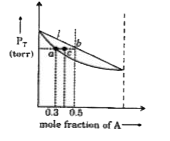Assertion : Increase in dielectric constant is observed in Frenkel defect.
Reason : Ions come in interstitial space in case of Frenkel defect.Solution in Malayalam
If both (A) and ( R) are correct and ( R) is the correct explanation of(A).
If both (A) and ( R) are correct, but ( R) is not the correct explanation of (A).
If (A) is correct, but ( R) is incorrect.
If both (A) and ( R) are incorrect.
The correct Answer is:A
Step by step video, text & image solution for Assertion : Increase in dielectric constant is observed in Frenkel defect. Reason : Ions come in interstitial space in case of Frenkel defect. by Chemistry experts to help you in doubts & scoring excellent marks in Class 12 exams.
Topper's Solved these Questions
- BOOK - BRILLIANT PUBLICATIONCHAPTER - SOLID STATEEXERCISE - QUESTIONS14videos
SOLID STATE
- BOOK - BRILLIANT PUBLICATIONCHAPTER - SOLID STATEEXERCISE - LEVEL-150videos
SOLID STATE
- BOOK - BRILLIANT PUBLICATIONCHAPTER - SOLID STATEEXERCISE - LEVEL-II50videos
SOLID STATE
- BOOK - BRILLIANT PUBLICATIONCHAPTER - REDOX REACTION & ELECTROCHEMISTRYEXERCISE - QUESTION (ELECTROCHEMISTRY) (LEVEL -II) (ASSERTION-REASON)3videos
REDOX REACTION & ELECTROCHEMISTRY
- BOOK - BRILLIANT PUBLICATIONCHAPTER - SOLUTIONSEXERCISE - Level-III (Linked Comprehension Type)12videos
SOLUTIONS
Similar Questions
A compound of elements X and Y crystallizes in cubic structure where X atoms occupy the corners of the cube and Y atoms occupy the centre of the cube. What is the formula of the compound?
02:29View SolutionThe radius of a di val ent cation M2+ is 94 pm and of divalent anion X2− is 146 pm. Thus, M2X2− has
View SolutionTotal number of voids in 0.5 mole of a compound forming hexagonal closed packed structure are
00:52View SolutionAssertion: After the electrolysis of aqueous CuSO4 solution pH decreases.
Reason: Sulphuric acid is formed.02:12View Solution1 mole of A and 1 mole B are mixed together to form an ideal solution at 25∘C. Solution is placed in a vessel fitted with piston. If pressure on the solution is reduced isothermally.

Correct relationship between P∘AandP∘B is02:01View SolutionAssertion: Increase in dielectric constant is observed for crystals having Frenkel defect
Reason: Similarly charged cations come closer in the crystal lattice02:21View SolutionAssertion (A) Due to Frenkel defect there is no effect on density of a solid. Reason (R) Ions shift from lattice sites to interstitial sites in Frenkel defect.
01:41View Solution(A) Frenkel defect increases the dielectric constant of the solid.
(R)In Frenkel defect like charged ions come closer.View SolutionAssertion : Due to Frenkel defect, density of the crystalline solid decreases. Reason : In Frenkel defect, cation or anion leaves the crystal.
01:47View SolutionAssertion (A) Both Frenkel and Schottky defects are stoichiometric defects. Reason (R ) Both defects change the density of the crystalline solid.
03:16View SolutionAssert : due to Frenkel defect, density of the crystalline solid decrases. Reason : in Frenkel defect cation and anion leaves the crystal.
02:03View SolutionGive reasons : In stoichiometric defects, NaCl exhibits Schottky defect and not Frenkel defect.
02:03View SolutionAssertion : due to Frenkel defect, density of the crystalline solid decreases. Reason : in Frenkel defect cation and anion leaves the crystal.
View SolutionAssertion : In Frenkel defect, density of the crystalline solid does not change.
Reason : In Frenkel defect, no cation or anion leaves the crystal.03:42View Solutionफ्रेन्केल दोष सामान्यतः किसमें प्रेक्षित होता है?
03:31View Solution

